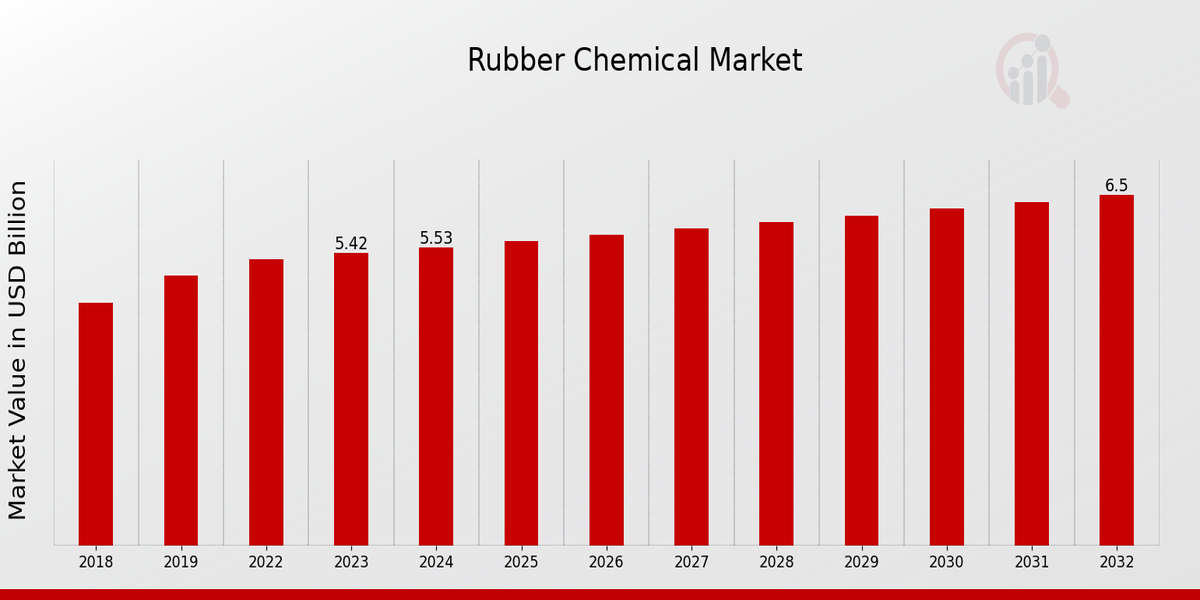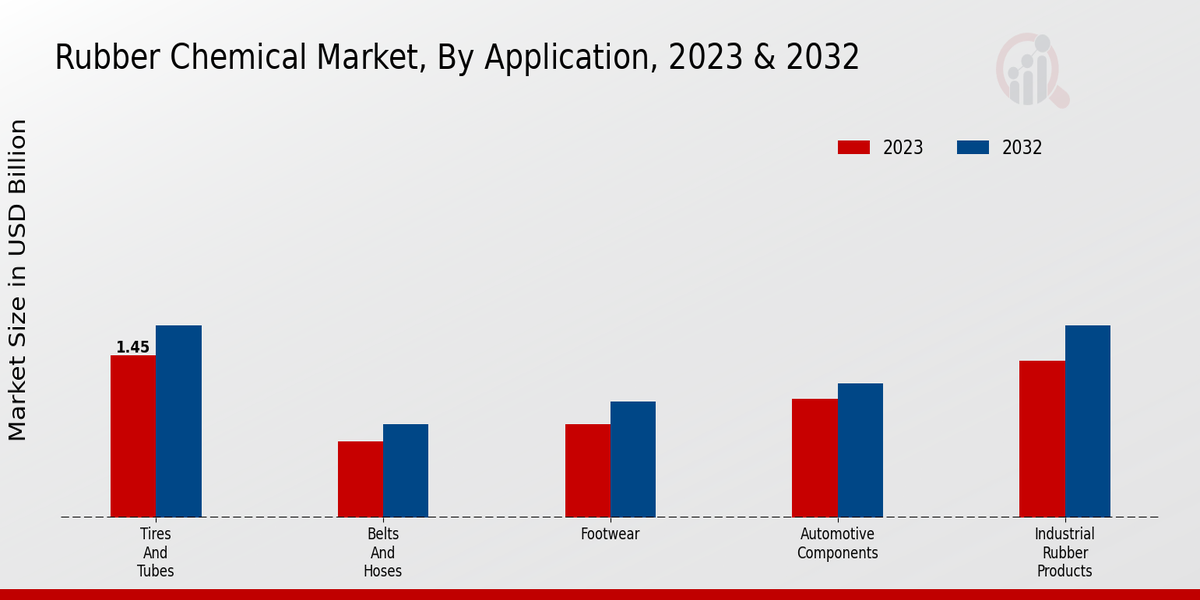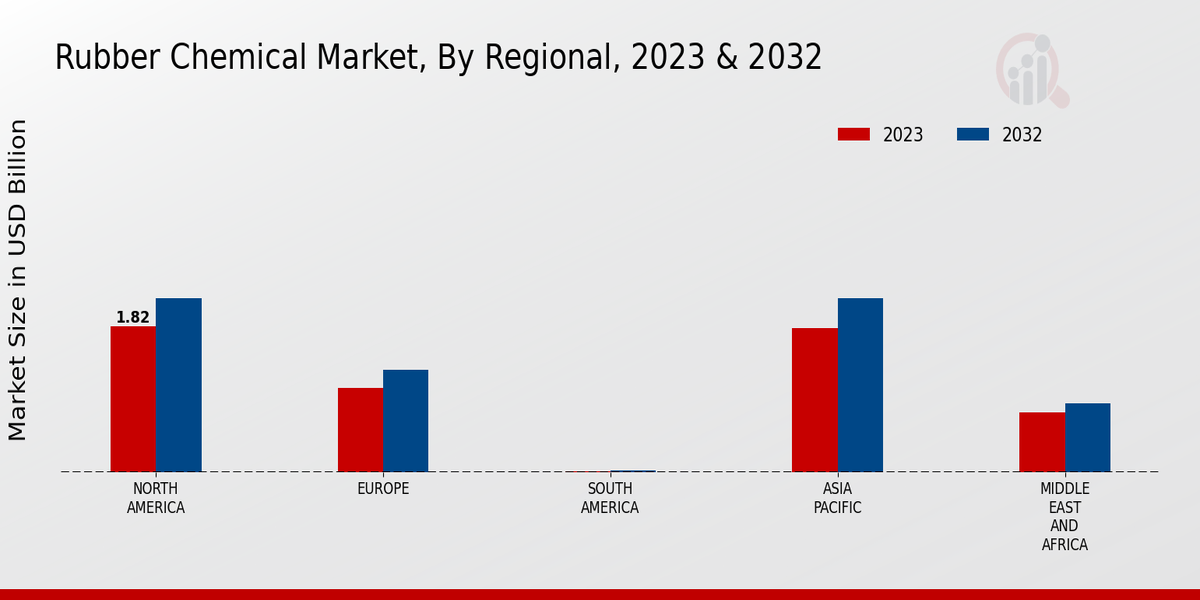Global Rubber Chemical Market Overview
The Rubber Chemical Market Size was estimated at 5.37 (USD Billion) in 2023.The Rubber Chemical Industry is expected to grow from 5.52(USD Billion) in 2024 to 7.5 (USD Billion) by 2035. The Rubber Chemical Market CAGR (growth rate) is expected to be around 2.83% during the forecast period (2025 - 2035).
Key Rubber Chemical Market Trends Highlighted
The Rubber Chemical Market is propelled by an increase in products which rely on rubber in the automotive and manufacturing industries. Advanced performance materials require enhanced rubber chemicals to improve the properties of rubber such as its toughness, elasticity, strength, and even its abrasion resistance. Moreover, the increasing attention towards environmental sustainability is driving manufacturers to look for green rubber chemicals. This can be observed as companies try to make innovations that lead to a decrease in the pollution caused by the production processes which resulted in the development of bio based and recyclable rubber chemicals.Particular attention has to be paid to the development of eco-friendly alternatives that meet strict regulation requirements from different governments regarding pollution and waste management because these avenues have yet to be fully explored. Other than responding to a consumer need, taking this step could also enable the industry to access new markets and partners. Some recent trends suggest volatility in the prices of rubber chemical raw materials and disruptions in the supply chains of important constituents which change the availability of these components. To responsive strategies, there are claims that changed their sourcing strategies and decided to contract with indigenous suppliers to lessen the danger of losing access to these constituents. The automation and digitalization of the processes involved in manufacturing is also an emerging trend as they allow businesses to optimize the production processes and lower costs which in effect changes market dynamics.The Rubber Chemical Market keeps changing on the basis of innovations and consumer tastes, which aligns with international sustainability strategies, motivating the shift.

Source: Primary Research, Secondary Research, MRFR Database and Analyst Review
Rubber Chemical Market Drivers
Increasing Demand for Sustainable Rubber Products
The Rubber Chemical Market Industry is witnessing an increased demand for sustainable and eco-friendly rubber products. According to the Environment Facility, sustainable production methods have gained traction, as consumers are increasingly prioritizing environmentally friendly products. This demand is fueled by various initiatives launched by organizations such as the United Nations Environment Programme, which promotes sustainable development goals.It is projected that the consumption of natural rubber will rise, particularly for applications in automotive production and consumer goods manufacturing, leading to a growth in rubber chemicals that support this trend. In response, many companies have been investing heavily in Research and Development (R) to develop bio-based and recyclable rubber chemicals, enhancing their market presence and aligning with sustainability goals.
Growth in Automotive and Manufacturing Industries
The Rubber Chemical Market Industry is significantly driven by the growth of the automotive and manufacturing sectors. The International Organization of Motor Vehicle Manufacturers reported that vehicle production has seen a steady recovery post-pandemic, with approximately 77 million vehicles produced in 2021 alone. This upturn is expected to drive an increased need for rubber chemicals, essential for tire manufacturing and other vehicle components.Moreover, as the automotive industry shifts toward electric vehicles, new types of rubber formulations and associated chemicals will be sought after to meet advanced performance specifications, further amplifying growth in this market segment. Consequently, major automotive companies are diversifying their supply chains, which favors the use of innovative rubber chemicals.
Technological Advancements in Rubber Chemical Production
The Rubber Chemical Market Industry is benefiting from rapid technological advancements in the production of rubber chemicals. Innovations in technologies such as polymer science and chemical engineering have led to the development of novel rubber compounds that enhance performance and durability, catering to industries like construction and aerospace. According to the National Research Council, advanced materials are a critical component of modern industrial applications, as they can lead to improved efficiency and longevity of products.Leading organizations in the chemical sector are actively filing patents for new rubber formulations, resulting in an expansive pipeline of innovative materials that will fortify the competitive landscape and cater to emerging industry requirements, thereby driving market growth.
Rubber Chemical Market Segment Insights
Rubber Chemical Market Application Insights
The Rubber Chemical Market, particularly focusing on the Application segment, shows a diverse landscape driven by various industries. In 2024, the market was valued at 5.52 USD Billion, reflecting significant growth potential. Within this segment, Tire Manufacturing emerges as a key player, with a value of 2.2 USD Billion in 2024 and a predicted increase to 3.0 USD Billion by 2035, highlighting its majority holding in the Rubber Chemical Market revenue. The tire sector is essential due to the growing demand for vehicles worldwide, as it directly correlates with increased tire production, thus necessitating rubber chemicals for better performance and durability.The Adhesives application is also noteworthy, valued at 1.4 USD Billion in 2024 and set to rise to 1.9 USD Billion by 2035, driven by the expanding construction and automotive sectors. Sealants are positioned at 0.74 USD Billion in 2024, likely reaching 1.0 USD Billion in 2035, making them significant in various industries for effective bonding and insulation purposes. Coatings, with a market value of 0.66 USD Billion in 2024 and projected to grow to 0.82 USD Billion by 2035, play a vital role in protecting surfaces, enhancing durability, and providing aesthetic appeal across multiple applications.Lastly, Latex Products are anticipated to grow from 0.52 USD Billion in 2024 to 0.78 USD Billion in 2035, reflecting their importance in medical, household, and industrial applications. Each of these applications contributes to a robust Rubber Chemical Market segmentation; thus, the interplay of these various segments is crucial as they respond to emerging market trends, driven by sustainability demands and technological advancements. The overall market growth is positively influenced by the need for high-performance materials across diverse applications, although challenges may arise due to fluctuating raw material prices and environmental regulations.Nevertheless, the expanding scope of rubber chemicals across these applications presents numerous opportunities for innovation and market expansion, indicating a favorable trajectory for the Rubber Chemical Market industry.

Source: Primary Research, Secondary Research, MRFR Database and Analyst Review
Rubber Chemical Market Type Insights
The Type segment of the Rubber Chemical Market encompasses essential categories that play a critical role in enhancing the performance and durability of rubber products. The overall market is expected to reach a valuation of 5.52 USD Billion in 2024 and is projected to continue its growth towards 7.5 USD Billion by 2035. Among the various categories, Anti-Degradants hold a prominent position as they significantly enhance the longevity of rubber by preventing degradation caused by environmental factors. Accelerators, on the other hand, are crucial for speeding up the vulcanization process, making them indispensable in rubber manufacturing.Vulcanizing Agents also play a significant role in improving the elasticity and strength of rubber products. Additionally, Fillers are important, as they not only reduce production costs but also enhance certain properties of rubber such as strength and durability. Antioxidants serve to protect rubber materials from oxidative degradation, thereby increasing their lifespan. The increasing demand for high-performance tires and various rubber-based products is driving innovations within these essential categories. Overall, this segmentation is crucial in determining the performance characteristics of rubber materials in diverse applications across the market.
Rubber Chemical Market End Use Insights
The Rubber Chemical Market, a vital component within the materials sector, was valued at 5.52 USD Billion by 2024, demonstrating the increasing demand for rubber chemicals across various end-use applications. The market segmentation reveals key areas, including Automotive, Industrial, Consumer Goods, Construction, and Healthcare. The Automotive sector plays a crucial role, as rubber chemicals are essential in manufacturing tires and other components, ensuring safety and performance. Similarly, the Industrial segment benefits significantly from rubber chemicals in the production of seals, gaskets, and conveyor belts, enhancing durability and functionality.The Consumer Goods segment, which includes items like footwear and sporting goods, relies on innovative rubber formulations for enhanced comfort and longevity. The Construction sector utilizes rubber chemicals in waterproofing and insulation materials, contributing to structural integrity. Finally, the Healthcare segment increasingly incorporates rubber chemicals in medical devices and healthcare products, reflecting the growing need for high-quality materials in this field. With an expected market growth supported by these diverse applications, understanding the dynamics of each segment is vital for stakeholders aiming to capitalize on the market opportunities ahead.
Rubber Chemical Market Form Insights
The Rubber Chemical Market is poised for significant growth, reached a value of 5.52 billion USD by 2024 and further escalating to 7.5 billion USD by 2035. This market encompasses various forms, including Liquid, Solid, and Powder, each playing a pivotal role in different applications. Liquid rubber chemicals are essential for their ease of application and fast cure times, catering to industries requiring quick turnaround times. Solid forms, on the other hand, are widely recognized for their durability and high-performance characteristics, making them ideal for heavy-duty applications.Powdered rubber chemicals dominate the market due to their versatility and widespread usage across multiple sectors, including automotive and construction. However, challenges such as fluctuating raw material prices and stringent environmental regulations may impact market dynamics. Opportunities abound as industries increasingly focus on innovative rubber formulations and sustainable practices, emphasizing the importance of understanding Rubber Chemical Market segmentation and statistics to navigate the evolving landscape.
Rubber Chemical Market Regional Insights
The Rubber Chemical Market showcases substantial growth potential across various regions, with an overall market valuation reached 5.52 USD Billion in 2024. North America is projected at 1.65 USD Billion, followed closely by Europe at 1.75 USD Billion, highlighting their significant contributions to market dynamics. The APAC region leads with a valuation of 1.85 USD Billion, underlining its dominance in the industry due to robust manufacturing and high demand for rubber products. Meanwhile, South America and the Middle East and Africa (MEA) contribute valuations of 0.45 USD Billion and 0.82 USD Billion respectively, reflecting their emerging roles in the market.The variations in regional performances stem from differing industrial activities, with the APAC region benefitting from its extensive automotive and industrial sectors. Overall, the segmentation of the Rubber Chemical Market indicates diverse opportunities and challenges, driven by varying regulatory frameworks, regional innovations, and market demands. The continuous growth of the automotive industry and increasing infrastructure investment are pivotal in shaping regional market trajectories, influencing both the supply chain and product development initiatives.

Source: Primary Research, Secondary Research, MRFR Database and Analyst Review
Rubber Chemical Market Key Players and Competitive Insights
The Rubber Chemical Market is a dynamic and multifaceted arena characterized by a wide array of players and a diverse portfolio of products. As industries increasingly focus on enhancing the performance and durability of rubber products, the demand for rubber chemicals has skyrocketed. This market features a combination of established players and emerging entities that continuously innovate to offer specialized solutions that meet the evolving needs of end-users. Competition is primarily driven by factors such as product quality, pricing strategies, technological advancements, and the ability to cater to specific customer requirements across various applications, including automotive, industrial, and consumer goods.Solvay stands out prominently in the Rubber Chemical Market with its extensive range of high-performance chemical solutions tailored for rubber manufacturing. The company is recognized for its strong commitment to providing innovative products that enhance the physical properties of rubber, such as flexibility, durability, and heat resistance. Solvay's robust RD capabilities allow it to stay ahead of market trends and develop cutting-edge solutions, ensuring that its offerings remain competitive. With a well-established presence, the company leverages multiple production sites and a broad distribution network to cater to the needs of diverse industries, underscoring its position as a leader in the rubber chemicals sector.DuPont is another significant player in the Rubber Chemical Market, offering a variety of essential chemicals and additives crucial for rubber processing. Known for its innovative portfolio, DuPont provides a range of products including accelerators, antioxidants, and plasticizers specifically designed for rubber applications. The company's commitment to sustainability and its focus on developing eco-friendly alternatives also enhance its market presence, appealing to environmentally conscious manufacturers. DuPont's strategic mergers and acquisitions have enabled it to strengthen its product portfolio and expand its footprint. This aligns with its goal to continually improve the performance characteristics of rubber products while meeting the stringent quality standards required by its clientele. With an emphasis on research and development, DuPont is well-positioned to address the ongoing challenges in the rubber industry and maintain its competitive advantage.
Key Companies in the Rubber Chemical Market Include
Rubber Chemical Market Industry Developments
Recent developments in the Rubber Chemical Market have been significant, particularly with the ongoing demand for eco-friendly alternatives and advancements in manufacturing technologies. Companies like Solvay and DuPont have been focusing on sustainability, investing in greener production methods that reduce environmental impact. Notable acquisitions have occurred, such as Hexpol's acquisition of a leading rubber compounding facility in August 2022, aimed at enhancing their market position and capacity. Lanxess has announced plans to expand its production capabilities in May 2023, targeting increased output of synthetic rubber. The market also saw Kraton Corporation launching a new range of bio-based rubber chemicals, aligning with shifts towards sustainable materials. In addition, BASF and AkzoNobel have engaged in strategic collaborations to innovate in rubber processing and improve performance characteristics. The valuation of companies in this sector is witnessing growth, attributed to rising automotive production and demand for high-performance tires, significantly impacting market dynamics. Over the past few years, developments such as Eastman Chemical Company's strategic investments in recycling technologies, announced in March 2021, have highlighted the industry's focus on circular economy principles, further transforming the Rubber Chemical landscape.
Rubber Chemical Market Segmentation Insights
Rubber Chemical Market Application Outlook
-
Tire Manufacturing
-
Adhesives
-
Sealants
-
Coatings
-
Latex Products
Rubber Chemical Market Type Outlook
-
Anti-Degradants
-
Accelerators
-
Vulcanizing Agents
-
Fillers
-
Antioxidants
Rubber Chemical Market End Use Outlook
-
Automotive
-
Industrial
-
Consumer Goods
-
Construction
-
Healthcare
Rubber Chemical Market Form Outlook
Rubber Chemical Market Regional Outlook
-
North America
-
Europe
-
South America
-
Asia Pacific
-
Middle East and Africa
|
Report Attribute/Metric
|
Details
|
|
Market Size 2023
|
5.37 (USD Billion)
|
|
Market Size 2024
|
5.52 (USD Billion)
|
|
Market Size 2035
|
7.5 (USD Billion)
|
|
Compound Annual Growth Rate (CAGR)
|
2.83% (2025 - 2035)
|
|
Report Coverage
|
Revenue Forecast, Competitive Landscape, Growth Factors, and Trends
|
|
Base Year
|
2024
|
|
Market Forecast Period
|
2025 - 2035
|
|
Historical Data
|
2019 - 2024
|
|
Market Forecast Units
|
USD Billion
|
|
Key Companies Profiled
|
Solvay, DuPont, Hexpol, Lanxess, OMNOVA Solutions, Kraton Corporation, Eastman Chemical Company, AkzoNobel, Crompton Corporation, BASF, Wacker Chemie AG, Archer Daniels Midland Company, RTP Company, Sky NRG
|
|
Segments Covered
|
Application, Type, End Use, Form, Regional
|
|
Key Market Opportunities
|
Sustainable rubber chemical development, Increased electric vehicle production, Growth in construction applications, Expanding focus on eco-friendly materials, Innovations in tire manufacturing technologies
|
|
Key Market Dynamics
|
Increasing demand for tires, Growth of automotive industry, Rising environmental regulations, Technological advancements in manufacturing, Fluctuating raw material prices
|
|
Countries Covered
|
North America, Europe, APAC, South America, MEA
|
Frequently Asked Questions (FAQ) :
The Rubber Chemical Market was expected to be valued at 5.52 USD Billion in 2024.
By 2035, the Rubber Chemical Market is projected to reach a value of 7.5 USD Billion.
The expected CAGR for the Rubber Chemical Market from 2025 to 2035 is 2.83%.
By 2035, North America is expected to have a market value of 2.15 USD Billion, making it one of the largest regions.
The market value for the Tire Manufacturing application was expected to be 2.2 USD Billion in 2024.
The Adhesives segment is projected to reach a value of 1.9 USD Billion by 2035.
Major players in the Rubber Chemical Market include Solvay, DuPont, and BASF.
The Sealants application is projected to be valued at 0.74 USD Billion in 2024.
The APAC region is expected to reach a market value of 2.45 USD Billion by 2035.
The market may face challenges such as fluctuating raw material prices and regulatory changes affecting manufacturing.

















